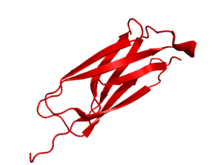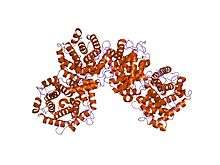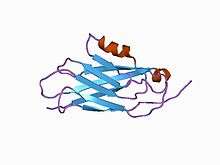alpha-2-Macroglobulin
| alpha-2-macroglobulin | |
|---|---|
 Crystal structure of alpha-2-macroglobulin. Rendered from PDB 2P9R. | |
| Identifiers | |
| Symbol | A2M |
| Entrez | 2 |
| HUGO | 7 |
| OMIM | 103950 |
| RefSeq | NM_000014 |
| UniProt | P01023 |
| Other data | |
| Locus | Chr. 12 p13.31 |
| Alpha-2-macroglobulin family | |||||||||
|---|---|---|---|---|---|---|---|---|---|
| Identifiers | |||||||||
| Symbol | A2M | ||||||||
| Pfam | PF00207 | ||||||||
| Pfam clan | CL0011 | ||||||||
| InterPro | IPR001599 | ||||||||
| PROSITE | PDOC00440 | ||||||||
| SCOP | 1c3d | ||||||||
| SUPERFAMILY | 1c3d | ||||||||
| |||||||||
| A-macroglobulin complement component | |||||||||
|---|---|---|---|---|---|---|---|---|---|
 n-terminally truncated c3dg fragment | |||||||||
| Identifiers | |||||||||
| Symbol | A2M_comp | ||||||||
| Pfam | PF07678 | ||||||||
| Pfam clan | CL0059 | ||||||||
| InterPro | IPR011626 | ||||||||
| PROSITE | PDOC00440 | ||||||||
| SCOP | 1bv8 | ||||||||
| SUPERFAMILY | 1bv8 | ||||||||
| |||||||||
| MG2 (macroglobulin) domain | |||||||||
|---|---|---|---|---|---|---|---|---|---|
| Identifiers | |||||||||
| Symbol | A2M_N | ||||||||
| Pfam | PF01835 | ||||||||
| Pfam clan | CL0159 | ||||||||
| InterPro | IPR002890 | ||||||||
| SCOP | 2a73 | ||||||||
| SUPERFAMILY | 2a73 | ||||||||
| |||||||||
| Alpha-2-macroglobulin family N-terminal region | |||||||||
|---|---|---|---|---|---|---|---|---|---|
| Identifiers | |||||||||
| Symbol | A2M_N_2 | ||||||||
| Pfam | PF07703 | ||||||||
| InterPro | IPR011625 | ||||||||
| |||||||||
| A2M receptor domain region | |||||||||
|---|---|---|---|---|---|---|---|---|---|
 receptor domain from alpha-2-macroglobulin | |||||||||
| Identifiers | |||||||||
| Symbol | A2M_recep | ||||||||
| Pfam | PF07677 | ||||||||
| InterPro | IPR009048 | ||||||||
| PROSITE | PDOC00440 | ||||||||
| SCOP | 1bv8 | ||||||||
| SUPERFAMILY | 1bv8 | ||||||||
| |||||||||
alpha-2-Macroglobulin, also known as α2-macroglobulin and abbreviated as α2M and A2M, is a large plasma protein found in the blood. It is produced by the liver, and is a major component of the alpha-2 band in protein electrophoresis.
Alpha-2-Macroglobulin is the largest major nonimmunoglobulin protein in plasma. The alpha-2-macroglobulin molecule is synthesized mainly in liver, but also locally by macrophages, fibroblasts, and adrenocortical cells.
Alpha 2 macroglobulin acts as an antiprotease and is able to inactivate an enormous variety of proteinases. It functions as an inhibitor of fibrinolysis by inhibiting plasmin and kallikrein. It functions as an inhibitor of coagulation by inhibiting thrombin. Alpha-2-macroglobulin may act as a carrier protein because it also binds to numerous growth factors and cytokines, such as platelet-derived growth factor, basic fibroblast growth factor, TGF-β, insulin, and IL-1β.
No specific deficiency with associated disease has been recognized, and no disease state is attributed to low concentrations of alpha-2-macroglobulin.
The concentration of alpha-2-macroglobulin rises 10-fold or more in the nephrotic syndrome when other lower molecular weight proteins are lost in the urine. The loss of alpha-2-macroglobulin into urine is prevented by its large size. The net result is that alpha-2-macroglobulin reaches serum levels equal to or greater than those of albumin in the nephrotic syndrome, which has the effect of maintaining oncotic pressure.
Structure
Human alpha-2-macroglobulin is composed of four identical subunits bound together by -S-S- bonds.[1][2] In addition to tetrameric forms of alpha-2-macroglobulin, dimeric, and more recently monomeric aM protease inhibitors have been identified.[3][4]
Each monomer of Human alpha-2-macroglobulin is composed of many functional domains, including macroglobulin domains, a thiol ester-containing domain and a receptor-binding domain.[5]
Function
The alpha-macroglobulin (aM) family of proteins includes protease inhibitors,[6] typified by the human tetrameric alpha-2-macroglobulin (a2M); they belong to the MEROPS proteinase inhibitor family I39, clan IL. These protease inhibitors share several defining properties, which include (i) the ability to inhibit proteases from all catalytic classes, (ii) the presence of a 'bait region' (aka. a sequence of amino acids in an α2-macroglobulin molecule, or a homologous protein, that contains scissile peptide bonds for those proteinases that it inhibits) and a thiol ester, (iii) a similar protease inhibitory mechanism and (iv) the inactivation of the inhibitory capacity by reaction of the thiol ester with small primary amines. aM protease inhibitors inhibit by steric hindrance.[7] The mechanism involves protease cleavage of the bait region, a segment of the aM that is particularly susceptible to proteolytic cleavage, which initiates a conformational change such that the aM collapses about the protease. In the resulting aM-protease complex, the active site of the protease is sterically shielded, thus substantially decreasing access to protein substrates. Two additional events occur as a consequence of bait region cleavage, namely (i) the h-cysteinyl-g-glutamyl thiol ester becomes highly reactive and (ii) a major conformational change exposes a conserved COOH-terminal receptor binding domain [8] (RBD). RBD exposure allows the aM protease complex to bind to clearance receptors and be removed from circulation.[9] Tetrameric, dimeric, and, more recently, monomeric aM protease inhibitors have been identified.[3][4]
Alpha-2-macroglobulin is able to inactivate an enormous variety of proteinases (including serine-, cysteine-, aspartic- and metalloproteinases). It functions as an inhibitor of fibrinolysis by inhibiting plasmin and kallikrein. It functions as an inhibitor of coagulation by inhibiting thrombin.[10]
Alpha-2-macroglobulin has in its structure a 35 amino acid "bait" region. Proteinases binding and cleaving the bait region become bound to α2M. The proteinase-α2M complex is recognised by macrophage receptors and cleared from the system.

Disease
Alpha-2-macroglobulin levels are increased in nephrotic syndrome, a condition wherein the kidneys start to leak out some of the smaller blood proteins. Because of its size, alpha-2-macroglobulin is retained in the bloodstream. Increased production of all proteins means alpha-2-macroglobulin concentration increases. This increase has little adverse effect on the health, but is used as a diagnostic clue. Longstanding chronic renal failure can lead to amyloid by alpha-2-macroglobulin (see main article: amyloid).
A common variant (29.5%) (polymorphism) of alpha-2-macroglobulin leads to increased risk of Alzheimer's disease.[11][12]
Alpha-2-macroglobulin binds to and removes the active forms of the gelatinase (MMP-2 and MMP-9) from the circulation via scavenger receptors on the phagocytes.
References
- ↑ Andersen GR, Koch TJ, Dolmer K, Sottrup-Jensen L, Nyborg J (October 1995). "Low resolution X-ray structure of human methylamine-treated alpha 2-macroglobulin". J. Biol. Chem. 270 (42): 25133–41. doi:10.1074/jbc.270.42.25133. PMID 7559647.
- ↑ Sottrup-Jensen L, Stepanik TM, Kristensen T, Wierzbicki DM, Jones CM, Lønblad PB, et al. (1984). "Primary structure of human alpha 2-macroglobulin. V. The complete structure.". J Biol Chem. 259 (13): 8318–27. PMID 6203908.
- 1 2 Dodds AW, Law SK (December 1998). "The phylogeny and evolution of the thioester bond-containing proteins C3, C4 and alpha 2-macroglobulin". Immunol. Rev. 166: 15–26. doi:10.1111/j.1600-065X.1998.tb01249.x. PMID 9914899.
- 1 2 Armstrong PB, Quigley JP (1999). "Alpha2-macroglobulin: an evolutionarily conserved arm of the innate immune system". Dev. Comp. Immunol. 23 (4-5): 375–90. doi:10.1016/s0145-305x(99)00018-x. PMID 10426429.
- ↑ Doan N, Gettins PG (2007). "Human alpha2-macroglobulin is composed of multiple domains, as predicted by homology with complement component C3.". Biochem J. 407 (1): 23–30. doi:10.1042/BJ20070764. PMC 2267405
 . PMID 17608619.
. PMID 17608619. - ↑ Sottrup-Jensen L (July 1989). "Alpha-macroglobulins: structure, shape, and mechanism of proteinase complex formation". J. Biol. Chem. 264 (20): 11539–42. PMID 2473064.
- ↑ Enghild JJ, Salvesen G, Thøgersen IB, Pizzo SV (July 1989). "Proteinase binding and inhibition by the monomeric alpha-macroglobulin rat alpha 1-inhibitor-3". J. Biol. Chem. 264 (19): 11428–35. PMID 2472396.
- ↑ Enghild JJ, Thøgersen IB, Roche PA, Pizzo SV (February 1989). "A conserved region in alpha-macroglobulins participates in binding to the mammalian alpha-macroglobulin receptor". Biochemistry. 28 (3): 1406–12. doi:10.1021/bi00429a069. PMID 2469470.
- ↑ Van Leuven F, Cassiman JJ, Van den Berghe H (December 1986). "Human pregnancy zone protein and alpha 2-macroglobulin. High-affinity binding of complexes to the same receptor on fibroblasts and characterization by monoclonal antibodies". J. Biol. Chem. 261 (35): 16622–5. PMID 2430968.
- ↑ de Boer JP, Creasey AA, Chang A, Abbink JJ, Roem D, Eerenberg AJ, Hack CE, Taylor FB (December 1993). "Alpha-2-macroglobulin functions as an inhibitor of fibrinolytic, clotting, and neutrophilic proteinases in sepsis: studies using a baboon model". Infect. Immun. 61 (12): 5035–43. PMC 281280
 . PMID 7693593.
. PMID 7693593. - ↑ Blacker D, Wilcox MA, Laird NM, Rodes L, Horvath SM, Go RC, Perry R, Watson B, Bassett SS, McInnis MG, Albert MS, Hyman BT, Tanzi RE (August 1998). "Alpha-2 macroglobulin is genetically associated with Alzheimer disease". Nat. Genet. 19 (4): 357–60. doi:10.1038/1243. PMID 9697696.
- ↑ Kovacs DM (July 2000). "alpha2-macroglobulin in late-onset Alzheimer's disease". Exp. Gerontol. 35 (4): 473–9. doi:10.1016/S0531-5565(00)00113-3. PMID 10959035.
- McPherson & Pincus: Henry's Clinical Diagnosis and Management by Laboratory Methods, 21st ed.
- Firestein: Kelley's Textbook of Rheumatology, 8th edition.
External links
- The MEROPS online database for peptidases and their inhibitors: I39.001
- alpha 2-Macroglobulin at the US National Library of Medicine Medical Subject Headings (MeSH)
- A2M human gene location in the UCSC Genome Browser.
- A2M human gene details in the UCSC Genome Browser.